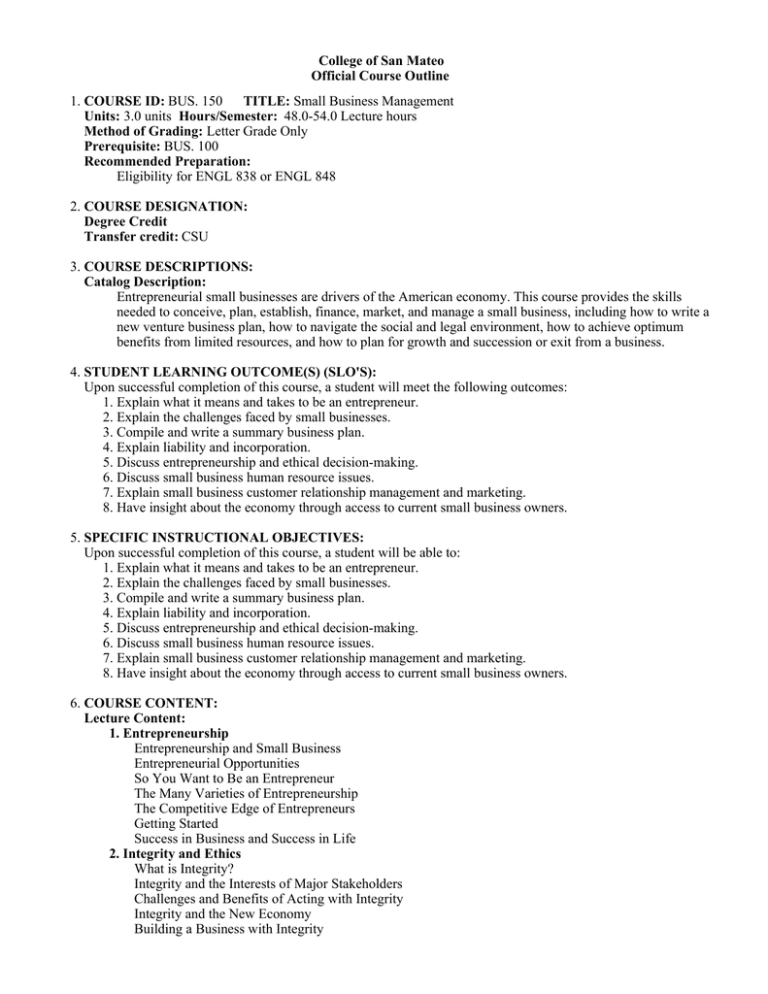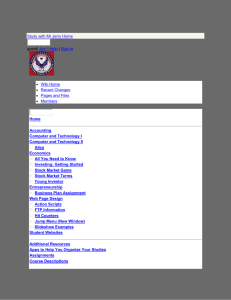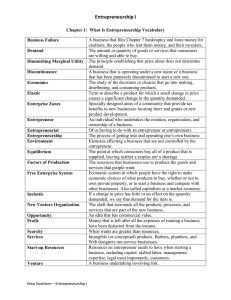College of San Mateo Official Course Outline COURSE ID: Units:
advertisement

College of San Mateo Official Course Outline 1. COURSE ID: BUS. 150 TITLE: Small Business Management Units: 3.0 units Hours/Semester: 48.0-54.0 Lecture hours Method of Grading: Letter Grade Only Prerequisite: BUS. 100 Recommended Preparation: Eligibility for ENGL 838 or ENGL 848 2. COURSE DESIGNATION: Degree Credit Transfer credit: CSU 3. COURSE DESCRIPTIONS: Catalog Description: Entrepreneurial small businesses are drivers of the American economy. This course provides the skills needed to conceive, plan, establish, finance, market, and manage a small business, including how to write a new venture business plan, how to navigate the social and legal environment, how to achieve optimum benefits from limited resources, and how to plan for growth and succession or exit from a business. 4. STUDENT LEARNING OUTCOME(S) (SLO'S): Upon successful completion of this course, a student will meet the following outcomes: 1. Explain what it means and takes to be an entrepreneur. 2. Explain the challenges faced by small businesses. 3. Compile and write a summary business plan. 4. Explain liability and incorporation. 5. Discuss entrepreneurship and ethical decision-making. 6. Discuss small business human resource issues. 7. Explain small business customer relationship management and marketing. 8. Have insight about the economy through access to current small business owners. 5. SPECIFIC INSTRUCTIONAL OBJECTIVES: Upon successful completion of this course, a student will be able to: 1. Explain what it means and takes to be an entrepreneur. 2. Explain the challenges faced by small businesses. 3. Compile and write a summary business plan. 4. Explain liability and incorporation. 5. Discuss entrepreneurship and ethical decision-making. 6. Discuss small business human resource issues. 7. Explain small business customer relationship management and marketing. 8. Have insight about the economy through access to current small business owners. 6. COURSE CONTENT: Lecture Content: 1. Entrepreneurship Entrepreneurship and Small Business Entrepreneurial Opportunities So You Want to Be an Entrepreneur The Many Varieties of Entrepreneurship The Competitive Edge of Entrepreneurs Getting Started Success in Business and Success in Life 2. Integrity and Ethics What is Integrity? Integrity and the Interests of Major Stakeholders Challenges and Benefits of Acting with Integrity Integrity and the New Economy Building a Business with Integrity 3. Starting a Small Business 3. Starting a Small Business Coming Up with Startup Ideas Using Innovative Thinking to Generate Business Ideas Using Internal and External Analyses to Assess Business Ideas Selecting Strategies That Capture Opportunities Is Your Startup Idea Feasible? Looking Forward 4. Franchises and Buyouts What is Franchising? The Pros and Cons of Franchising Evaluating Franchise Opportunities Buying an Existing Business 5. The Family Business What is Family Business? Family Business Momentum Family Roles and Relationships Good Governance in the Family Firm The Process of Leadership Succession 6. The Business Plan Overview of the Business Plan Preparing a Business Plan Resources for Business Plan Preparation Keeping the Right Perspective 7. The Marketing Plan What is Small Business Marketing? The Formal Marketing Plan Marketing Research for the Small Business Understanding Potential Target Markets Estimating Market Potential 8. The Organizational Plan Building a Management Team Choosing Legal Form of Organization Forming Strategic Alliances The Board of Directors 9. The Location Plan Locating the Brick-and-Mortar Startup Designing and Equipping the Physical Facilities Locating the Startup in the Entrepreneur’s Home Locating the Startup on the Internet 10. The Firm's Financial Statements Income Statement Balance Sheet Cash Flow Statement Evaluating Performance 11. Financial Requirements Financial Forecasting Forecasting Profitability Forecasting Asset and Financing Requirements Forecasting Cash Flows Debt or Equity Financing? Sources of Financing Harvesting 12. Customer Relations Customer Relationship Management Customer Profiles Psychological Influences on Customers Sociological Influence on Customers 13. Human Resources Recruiting Personnel Evaluating Prospects and Selecting Employees Training and Developing Employees Compensation and Incentives for Employees Human Resource Issues 14. Operations Operations Process Inventory Management Operations Management and Quality Purchasing Policies and Practices 15. Managing Risk What is Risk? Managing Basic Types of Pure Risk 7. REPRESENTATIVE METHODS OF INSTRUCTION: Typical methods of instruction may include: A. Lecture B. Discussion C. Guest Speakers D. Other (Specify): Case studies; group projects; oral presentations; role-playing; writing projects 8. REPRESENTATIVE ASSIGNMENTS Representative assignments in this course may include, but are not limited to the following: Writing Assignments: Writing a Business Plan for a prospective business. Written analysis of case studies. Written tests. Reading Assignments: Case studies and assigned chapters from course textbook. Other Outside Assignments: Research for written Business Plan. 9. REPRESENTATIVE METHODS OF EVALUATION Representative methods of evaluation may include: A. Class Participation B. Exams/Tests C. Group Projects D. Homework E. Oral Presentation F. Papers G. Written examination H. Case studies 10. REPRESENTATIVE TEXT(S): Possible textbooks include: A. Longnecker, Justin; Petty, J. William; Plaich, Leslie E.; Hoy, Frank. Small Business Management: Launching and Growing Entrepreneurial Ventures, ed. South- Western Cengage Learning, 2011 Origination Date: January 2014 Curriculum Committee Approval Date: October 2014 Effective Term: Fall 2015 Course Originator: Anne Figone





